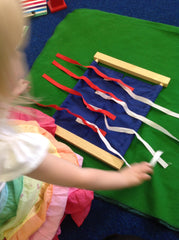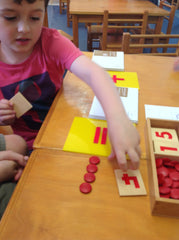To read the first entry in our Montessori Christmas Blog series please visit our post on 'Monte-Santa'.
Practical Life: a Montessori perspective on the productive, purposeful work of Christmas.
I have known many Montessori classrooms, and Montessori inspired parents, who seem to think that as Christmas approaches they need to hide the Pink Tower and bring out the Santa stickers. This seems to be founded on a belief that Christmas needs to be particularly "fun" and that it is so important that it should be present as a consistent "theme" in the classroom or home environment.
It is my belief that it is unnecessary to change the Montessori environment significantly when Christmas arrives. The existing materials and activities provide countless opportunities for fun, even 'themed', experiences relating to Christmas.
There are countless creative ways that you can inject a little bit of Christmas into the Montessori experience - you can use your own imagination to concoct unique variations.
For inspiration, here are a few examples of festive fun that can be found in the ordinary routines and materials of the Montessori environment...
Inset for Design: Christmas Style!
Several of the Inset shapes can be adapted to create Christmas shapes or symbols, as shown below;
Practical Life task: wrapping presents.
The act of wrapping a present can be treated like any other 'Practical Life' work. It is a useful skill that is relevant to the child's cultural context. As such it is entirely appropriate and authentic to present gift-wrapping as a Practical Life presentation in a Montessori classroom. It requires fine motor control, spatial reasoning and the use of multiple tools (scissors, sticky-tape and so forth).
The Ribbons Dressing Frame provides the perfect opportunity for a child to master the art of tying a ribbon and bow around a Christmas gift.
Christmas counting: making budgets.
The Christmas season tends to be a time of making 'lists'. I personally prefer to encourage children to write lists of gifts they wish to give rather than those they wish to receive. This shifts the child's perception of what Christmas is about, making it more about what one can do for others than just getting what you "want". Making gift lists also provides an opportunity for the child to consider a 'budget'. In an early childhood setting this could be as simple as considering two gifts, assessing their prices and using concrete materials to engage in some simple addition to identify the total spent. An older child could engage in a more complex process of counting his/her own savings, perusing catalogues or online outlets to identify gifts, then totalling the exact amount of the desired purchases before deducting this from the savings total.
Christmas cooking:
Montessori children engage in cooking all year round but the festive season provides extra incentive to incorporate specific themes (such as Christmas cookie shapes) or to include specific ingredients or flavours that are commonly associated with Christmas (such as cranberries or cinnamon).
After a child has helped to cook part of a Christmas meal then he or she can also help to set the table - by placing the plates and cutlery or by decorating it by arranging vases of flowers!
Christmas Literacy: opportunities for meaningful writing
The Christmas season provides an ideal opportunity to combine Literacy with Grace and Courtesy by encouraging a child to write 'thank you' cards for gifts received or writing and posting Christmas cards to friends and family.
Making Presents
Homemade, handmade gifts are the perfect way for a child to exercise their motor control and learn new skills while also building a connection with creativity not consumerism. There are, of course, countless items that a child could make as a gift for a friend or relative. Here are just a few examples of gifts or special creations that children have developed in my own classroom. Please note: the 'assembly-line model' of having every child reproduce a predetermined product is not aligned with authentic Montessori principles. Handmade items should, instead, reflect the child's interests, abilities and creativity as well as relating to the needs of the recipient.
-Christmas themed play dough
-Potpourri (made from dried lavender)









































Leave a comment: